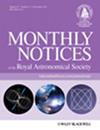Early stages of gap opening by planets in protoplanetary discs
IF 4.8
3区 物理与天体物理
Q1 ASTRONOMY & ASTROPHYSICS
引用次数: 0
Abstract
Annular substructures in protoplanetary discs, ubiquitous in sub-mm observations, can be caused by gravitational coupling between a disc and its embedded planets. Planetary density waves inject angular momentum into the disc leading to gap opening only after travelling some distance and steepening into shocks (in the absence of linear damping); no angular momentum is deposited in the planetary coorbital region, where the wave has not shocked yet. Despite that, simulations show mass evacuation from the coorbital region even in inviscid discs, leading to smooth, double-trough gap profiles. Here we consider the early, time-dependent stages of planetary gap opening in inviscid discs. We find that an often-overlooked contribution to the angular momentum balance caused by the time-variability of the specific angular momentum of the disc fluid (caused, in turn, by the time-variability of the radial pressure support) plays a key role in gap opening. Focusing on the regime of shallow gaps with depths of $\lesssim 20~{{\%}}$, we demonstrate analytically that early gap opening is a self-similar process, with the amplitude of the planet-driven perturbation growing linearly in time and the radial gap profile that can be computed semi-analytically. We show that mass indeed gets evacuated from the coorbital region even in inviscid discs. This evolution pattern holds even in viscous discs over a limited period of time. These results are found to be in excellent agreement with 2D numerical simulations. Our simple gap evolution solutions can be used in studies of dust dynamics near planets and for interpreting protoplanetary disc observations.原行星盘中行星打开间隙的早期阶段
原行星盘中的环状亚结构在亚微米观测中无处不在,可能是由行星盘与其内含行星之间的引力耦合造成的。行星密度波向圆盘注入角动量,只有在传播一段距离后才会导致缝隙打开,并陡变为冲击(在没有线性阻尼的情况下);在行星共轨区域没有角动量沉积,因为那里的波还没有发生冲击。尽管如此,模拟结果显示,即使在不粘性圆盘中,质量也会从共轨区疏散,从而导致平滑的双槽间隙剖面。在这里,我们考虑了不粘性圆盘中行星间隙打开的早期随时间变化的阶段。我们发现,由圆盘流体比角动量的时间可变性(反过来又由径向压力支持的时间可变性引起)引起的角动量平衡的一个经常被忽视的贡献在间隙打开中起着关键作用。我们重点研究了深度为$\lesssim 20~{{\%}}$的浅间隙体系,分析表明早期间隙打开是一个自相似过程,行星驱动的扰动振幅随时间线性增长,径向间隙剖面可以半分析计算。我们的研究表明,即使在不粘性圆盘中,质量也确实会从共轨道区域疏散。即使在粘性圆盘中,这种演变模式也会在有限的时间内保持不变。这些结果与二维数值模拟非常吻合。我们的简单间隙演化方案可用于研究行星附近的尘埃动力学和解释原行星盘的观测结果。
本文章由计算机程序翻译,如有差异,请以英文原文为准。
求助全文
约1分钟内获得全文
求助全文
来源期刊

Monthly Notices of the Royal Astronomical Society
ASTRONOMY & ASTROPHYSICS-
CiteScore
9.10
自引率
37.50%
发文量
3198
审稿时长
3 months
期刊介绍:
Monthly Notices of the Royal Astronomical Society is one of the world''s leading primary research journals in astronomy and astrophysics, as well as one of the longest established. It publishes the results of original research in positional and dynamical astronomy, astrophysics, radio astronomy, cosmology, space research and the design of astronomical instruments.
 求助内容:
求助内容: 应助结果提醒方式:
应助结果提醒方式:


